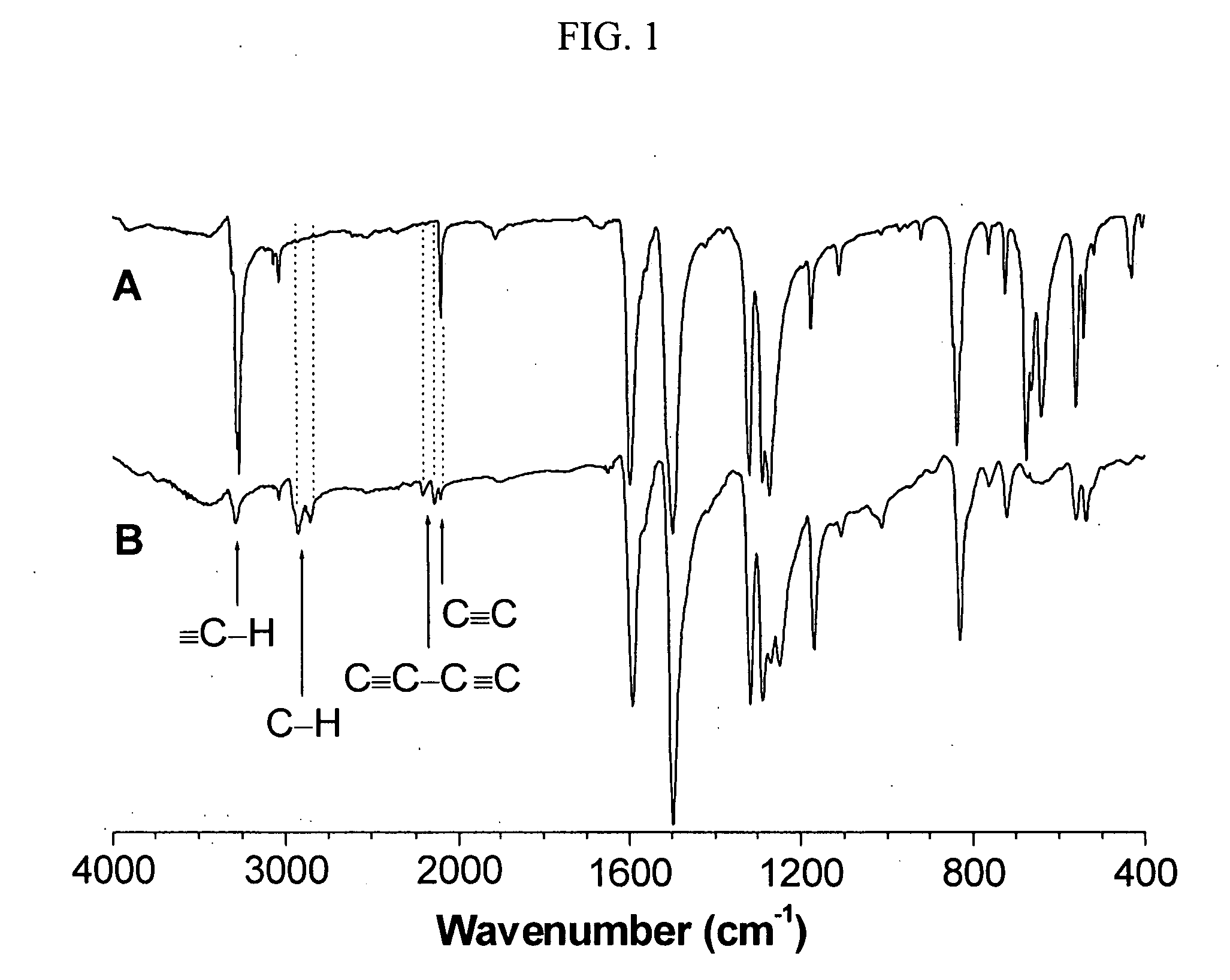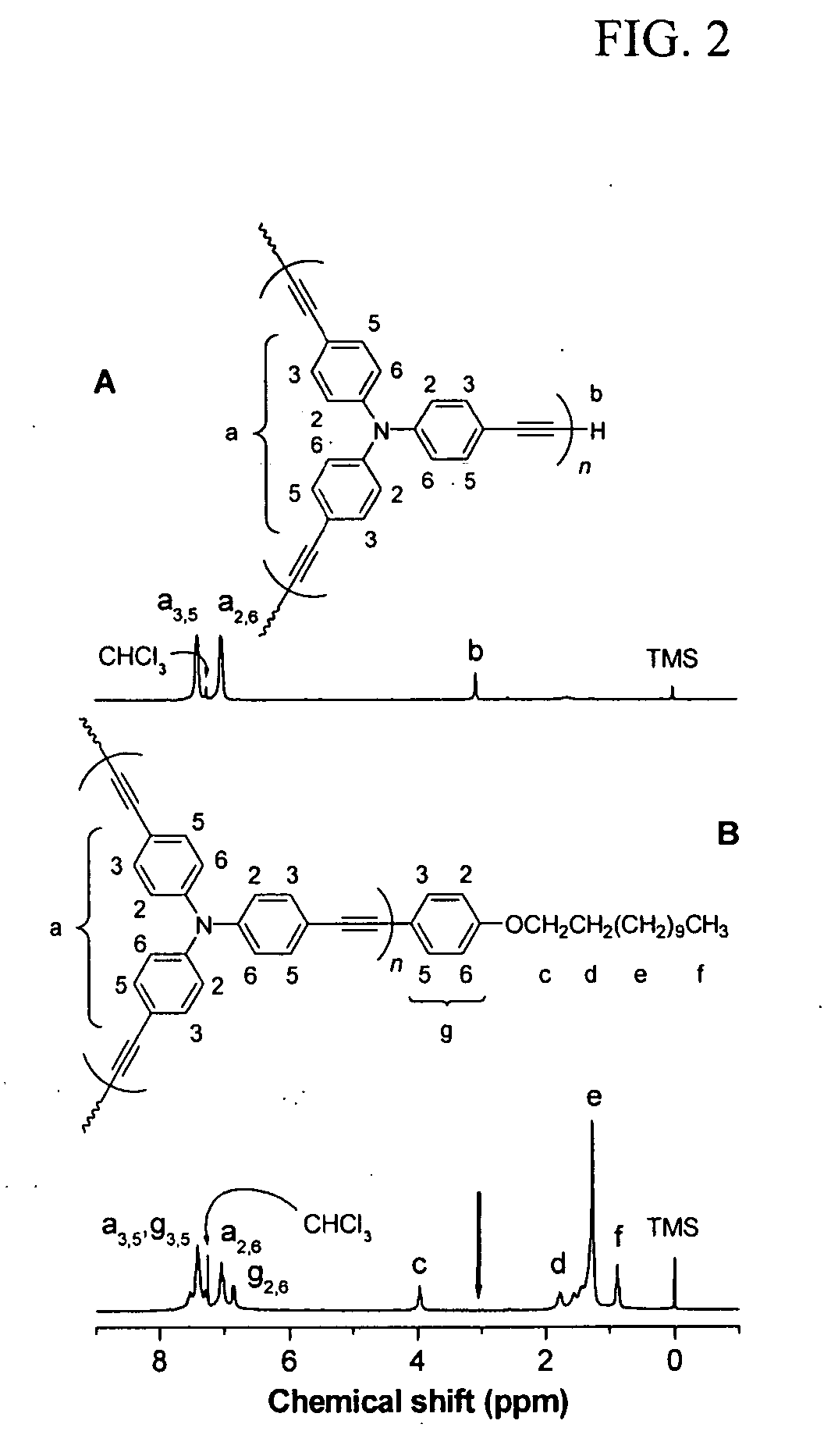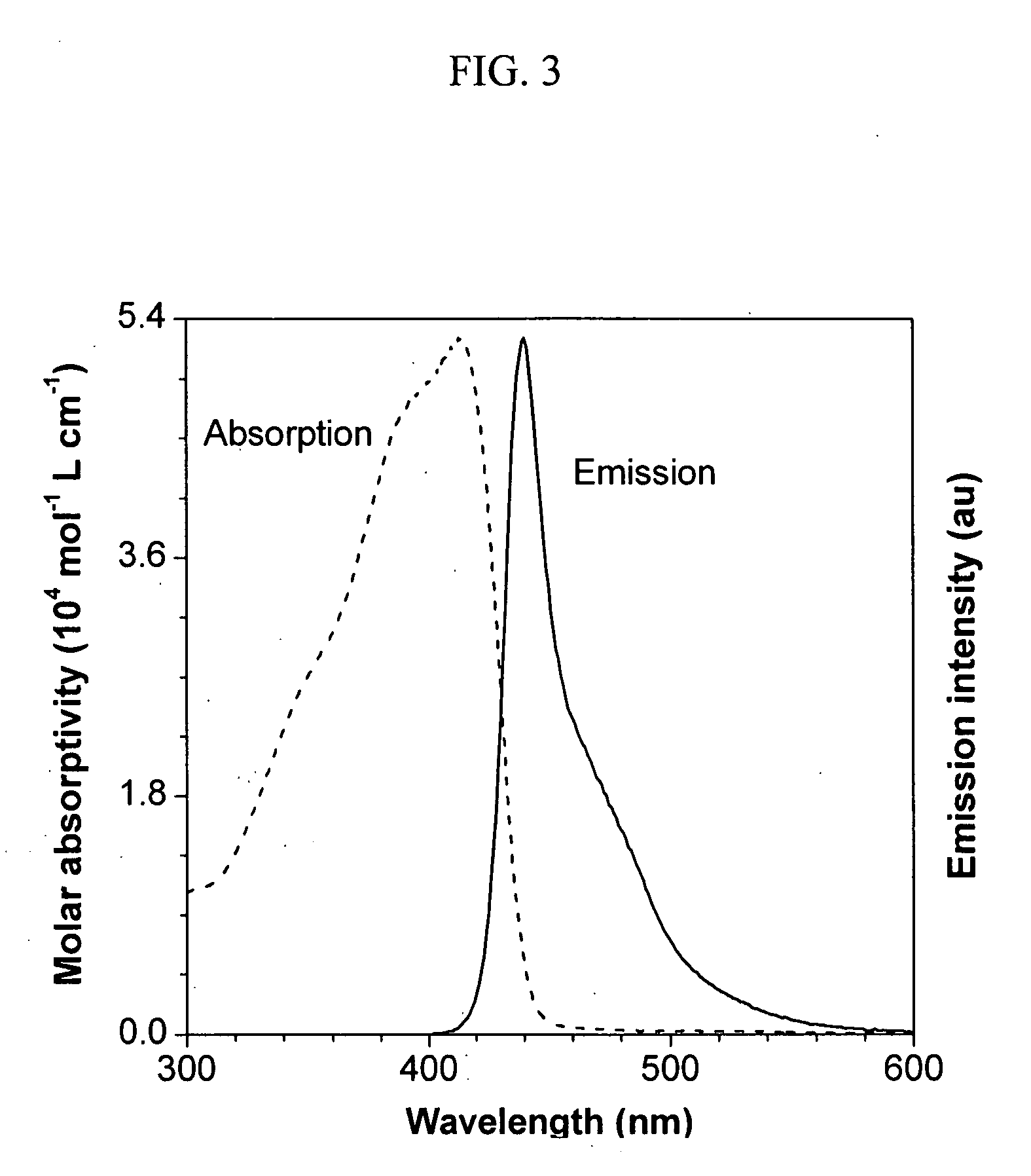Hyber-branched diacetylene polymers and their use in ceramics, photonic devices and coating films
a diacetylene polymer and hybrid branch technology, applied in the field of new useful organic materials, can solve the problems of limited linear structure, high amount, and only case of low molecular weight oligomer products, and achieve high char yield, high metal retention, and high soft magnetism.
- Summary
- Abstract
- Description
- Claims
- Application Information
AI Technical Summary
Benefits of technology
Problems solved by technology
Method used
Image
Examples
example 1
Hyperbranched poly{[tris(4-ethynylphenyl)aminelco-[(4-heptyloxy)phenyl-acetylene]}(I)
[0033]
[0034] Into a 20 mL test tube equipped with a magnetic stirrer were placed 2 mg (0.02 mmol) CuCl and 8 mg (0.07 mmol) N,N,N′,N-tetramethylethylenediamine (TMEDA) in 4 mL o-dichlorobenzene (o-DCB). The catalyst mixture was bubbled with a slow stream of compressed air and stirred on an oil bath at 50° C. for 15 min. Tris(4-ethynylphenyl)amine (126.8 mg, 0.4 mmol) and (4-heptyloxy)phenyl-acetylene (129.6 mg, 0.6 mmol) were dissolved in 1 mL o-DCB and then added into the catalyst mixture. After 30 min, the polymerization was stopped by pouring the reaction mixture into 300 mL of methanol acidified with 1 mL of a 37 wt % HCl solution. The polymer precipitate was filtered by a Gooch crucible, washed with methanol and hexane, dried in vacuum overnight at room temperature and yielded 146.7 mg of a yellow powder.
[0035] Characterization Data: GPC (polystyrene calibration): Mw 18200; PDI 5.3. IR (KBr),...
example 2
Hyperbranched poly[tris(4-ethynylphenyl)amine](II)
[0037]
[0038] Homopolymerization of tris(4-ethynylphenyl)amine was carried out in accordance with the same procedure as described in Example 1 without the addition of (4-heptyloxy)phenyl-acetylene. A yellow powder was obtained after 10 min in 65.6 mg yield. GPC (polystyrene calibration): Mw 24100; PDI 1.6. IR (KBr), v (cm−1): 3293 (≡C—H stretching), 2208, 2143 (C≡C—C≡C stretching), 2105 (C≡C stretching). 1H NMR (300 MHz, CDCl3), δ (ppm): 7.3-7.5 (Ar—H), 6.9-7.1 (Ar—H), 3.1 (≡CH). 13C NMR (75 MHz, CDCl3), δ (ppm): 147.33, 147.13, 146.95, 146.8, 146.63, 133.74, 133.45, 133.4, 125.01, 124.49, 124.21, 124.07, 123.77, 123.44, 117.46, 117.16, 116.75, 116.4, 116.06, 83.32, 83.27, 81.73, 81.64, 81, 58, 77.25, 77.12, 74.25, 74.11, 73.95.
[0039]FIG. 2A shows a 1H NMR spectrum of II, a homopolyyne, whose peaks are readily assignable: the resonance signals at δ 7.4, 7.0 (a), and 3.1 (b) are due to the absorptions of the aromatic and acetylenic p...
example 3
Hyperbranched poly(2-hexyloxy-1,3,5-triethynylbenzene) (III)
[0041]
[0042] Homopolymerization of 2-hexyloxy-1,3,5-triethynylbenzene was carried out in accordance with the same procedure as described in Example 2 with 100 mg (0.4 mmol) 2-hexyloxy-1,3,5-triethynylbenzene instead of (4-ethynylphenyl)amine. A white powder was obtained after 20 min in 76.1 mg yield.
[0043] GPC (polystyrene calibration): Mw 30700; PDI 3.6. (IR (KBr), v (cm−1): 3295 (≡C—H stretching), 2940, 2928 (C—H stretching), 2211 (C≡C—C≡C stretching), 648 (≡C—H bending). 1H NMR (300 MHz, CDCl3), δ (ppm): 7.4-7.7 (Ar—H), 4.4 (OCH2), 3.3 (≡CH), 3.0 (═CH), 1.7-2.2 (OCH2CH2), 1.2-1.7 (CH2), 0.9 (CH3). 13C NMR (75 MHz, CDCl3), 15 (ppm): 163.62, 138.89, 138.49, 117.42, 117.07, 116.57, 82.86, 82.6, 78.48, 78.35, 77.82, 77.21, 75.28, 75.03, 74.74, 31.64, 30.23, 25.62, 22.7, 14.08.
PUM
| Property | Measurement | Unit |
|---|---|---|
| Length | aaaaa | aaaaa |
| Length | aaaaa | aaaaa |
| Mass | aaaaa | aaaaa |
Abstract
Description
Claims
Application Information
 Login to View More
Login to View More - R&D
- Intellectual Property
- Life Sciences
- Materials
- Tech Scout
- Unparalleled Data Quality
- Higher Quality Content
- 60% Fewer Hallucinations
Browse by: Latest US Patents, China's latest patents, Technical Efficacy Thesaurus, Application Domain, Technology Topic, Popular Technical Reports.
© 2025 PatSnap. All rights reserved.Legal|Privacy policy|Modern Slavery Act Transparency Statement|Sitemap|About US| Contact US: help@patsnap.com



